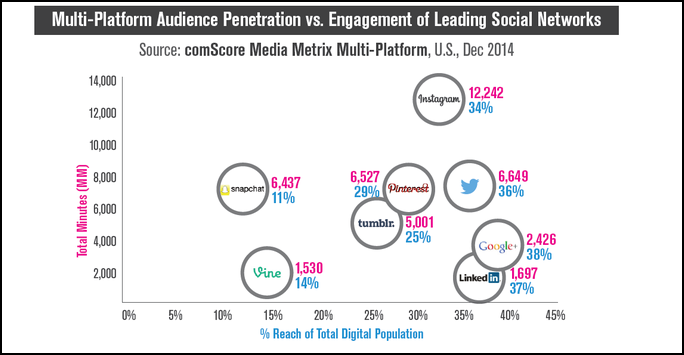by
Daniel Burstein, Director of Editorial Content
comScore pulls from a very large, ongoing Internet panel of approximately 1 million people online in the U.S. to understand how customers behave online. From a subset of that larger panel, the digital media analytics company discovered which social networks are most popular with customers.

Click here to see a printable version of this chart
Where’s Facebook?
It’s up there. Way up there. Outside the barriers of the chart.
Just like it is almost impossible to fit the sun into a model of the solar system because it is so much bigger than all the planets, comScore was unable to create a useful chart that included Facebook. Facebook has so much more total engagement that all of the other social networks would have been compressed into a small, indiscernible blotch in the bottom left corner of the chart.
Facebook reaches 81 percent of the total U.S. digital population and is home to nearly 230 billion minutes of user engagement.
That is almost 20 times more user engagement than the second-most sticky social network which is … also Facebook.
Facebook-owned Instagram, that is, which netted more than 12 billion minutes in time spent on the site.
Google+ had the second-highest reach of the total digital population in the U.S., probably helped by the fact that its parent website is the top-trafficked site in the country. That might just help a little bit with reach.
Even though Google+ reached more than a third of the population, it is among the least sticky of the social networks — besting only LinkedIn and six-second video looper, Vine.
Look past the numbers to find your audience
If you are a very big, mass market brand whose customers include the vast majority of the population, Facebook is probably a good fit for your marketing budget. Social networks like Twitter have defended themselves against Wall Street investors focused on scale over substance.
But should we treat social networks like the old days of the big three networks that reached almost everyone in America?
For stock market valuation, perhaps. Certainly mass reach (combined with the rich targeting data Facebook has) is valuable.
But as a marketer, you must overlook this buzz and ask …
Where do your customers gather and what do they care about?
It doesn’t matter that Facebook reaches 81 percent of the total U.S. digital population if customers don’t want to use it to interact with your product. For example, if you have a B2B service, perhaps your prospective customers don’t want to hear about it during Facebook time when their main focus is seeing pictures of the grandkids and sharing their trip to Yosemite.
Perhaps, even though LinkedIn only has about 1.7 billion total minutes of time spent on the site, those are rich minutes focused on solving business problems by networking and finding the right information to overcome their pain points. And for this reason, your brand should focus on LinkedIn.
While the above data is helpful and directional, you need to ask some key questions that are specific for your brand.
Look at your analytics — which social networks are sending the most traffic? Talk to your customers or survey them. Which social networks do they prefer? Do you have a social listening tool? If so, where are you getting the most mentions (even if your brand isn’t currently active on those platforms yet)?
- What information and engagement do customers want on that platform? Is it a good fit for your brand?
Like with the example above, just because your potential customers are on Facebook doesn’t mean they want to talk about your social media solution.
Do customers interact in a way that you can tell your brand’s story, and help them overcome their pain points and meet their goals on that platform? If you have a service that isn’t very visual, for example, you could be challenged to create compelling content for Instagram. So even if your ideal customers use it every day, it may not be the place for your brand.
- Do I have the resources to commit to this social network?
The social sphere is littered with hastily thrown together (and later abandoned) brand presence. If customers see an abandoned social account, what does that do to their trust in your brand? Will you abandon them as customers as easily as you abandoned that account?
I look at choosing a social network like having a baby. You better be committed to caring and feeding the account on that social network for 18 years … at a minimum.
That’s why the above selection criteria is so important. Don’t just choose the buzziest social networks. Choose the social networks that are the best fit for your customers and your brand. And make sure you are committed to sustaining that relationship.
Related Resources
Subscribe to MarketingSherpa Chart of the Week — Gain access to the data and discoveries you need to better serve customers
Facebook Ads: How Zappos.com manages a $10 million strategyWhich Social Networks Have the Most Engaged Audience? (by Adam Lella on comScore)
Community Marketing: 1 million Instagram impressions via creative design contest2015 U.S. Digital Future in Focus (white paper from comScore)
Social Media Marketing: How does Google+ fit into the social media puzzle?B2B Social Media Marketing: DocuSign's targeted LinkedIn InMail strategy creates 3 large pipeline opportunitiesSocial Media: How employees can help you deliver value on TwitterSocial Media: Understanding Pinterest consumersSocial Media Marketing: How New York Public Library increased card sign-ups by 35%4 Tips from Jonah Berger on Taking Content Marketing ViralSocial Media: 3 brands that totally get using VineNumber of Mobile-Only Internet Users Now Exceeds Desktop-Only in the U.S. (by Adam Lella on comScore)









